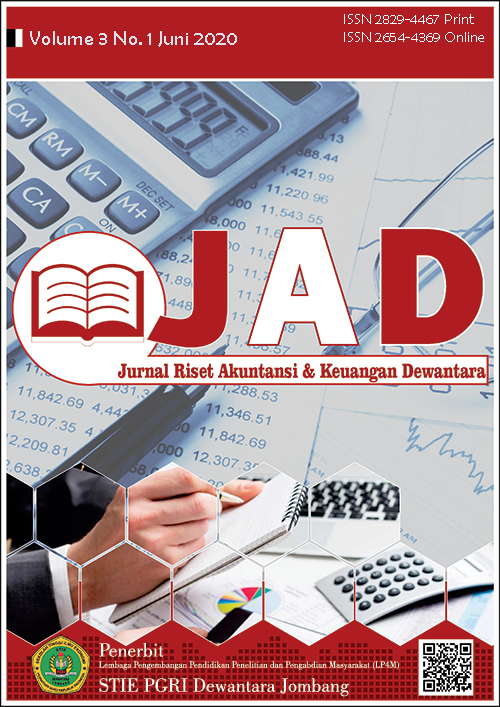Membandingkan Akurasi Financial Distress Berbasis Model Peramalan Kebangkrutan
 Abstract views: 459
,
Abstract views: 459
,
 PDF (Bahasa Indonesia) downloads: 519
PDF (Bahasa Indonesia) downloads: 519
Abstract
References
Aminian, H. & Olin, R., 2016. Investigate the ability of bankruptcy prediction models of Altman and Springate and Zmijewski and Grover in Tehran Stock Exchange. Mediterranean Journal of Social Sciences, 7(4), pp. 208-211.
Anon., n.d. Knowledge-Based Systems.
Chen, J., 2016. Financial distress prediction in China.". Review of Pacific Basin Financial Markets and Policies, 9(2), pp. 317-337.
Chen, W. S. & Yin, K. D., 2009. Using neural networks and data mining techniques for the financial distress prediction model. Expert systems with applications, 36(2), pp. 4075-4086.
Dietrich, J. R., 2015. Discussion of methodological issues related to the estimation of financial distress prediction models. Journal of Accounting Research, pp. 83-86.
Doumpos, M. & Constantin, Z., 2014. A multicriteria discrimination method for the prediction of financial distress: The case of Greece. Multinational Finance Journal, 3.2(2), pp. 71-101.
Fanning, K. & Kenneth, C., 2014. A comparative analysis of artificial neural networks using financial distress prediction. Intelligent Systems in Accounting, Finance and Managemen, 34(4), pp. 241-252.
Gepp, A. & Kuldeep, K., 2014. The role of survival analysis in financial distress prediction. International research journal of finance and economics, 6(4), pp. 13-34.
Gunawan, P., Pamungkas, H. & Merinti, A. S., 2017. Comparison of Financial Distress Predictions with Altman, Grover and Zmijewski Models. Jurnal Akuntansi dan Investasi, 18(1), pp. 119-127.
Hopwood, W., McKEOWN & Jane, R., 2016. The sensitivity of financial distress prediction models to departures from normality. Contemporary Accounting Research, 27(1), pp. 284-298.
Husein, A., Fakhri, M. & Galuh, T. P., 2015. Precision of the models of Altman, Springate, Zmijewski, and Grover for predicting the financial distress. Journal of Economics, Business, & Accountancy Ventura, 17(3), pp. 405-416.
Keasey, K. & Robert, W., 2014. Financial distress prediction models: a review of their usefulness. British journal of Management, 17(1), pp. 289-102.
Lau, A. & Hing, L., 2014. A five-state financial distress prediction model. Journal of accounting research, pp. 127-138.
Liang, D., Chih, F. T. & Hsin, T. W., 73. The effect of feature selection on financial distress prediction. Knowledge-Based Systems, 73(1), pp. 208-297.
McDoll, F. & Zumanikah, A. A., 2014. Prediction of fetal anemia with Doppler measurement of the middle cerebral artery peak systolic velocity in pregnancies complicated by maternal blood group alloimmunization or parvovirus B19 infection. Ultrasound in Obstetrics and Gynecology: The Official Journal of the International Society of Ultrasound in Obstetrics and Gynecology, 18(1), pp. 232-236.
Rondes, A., 2017. Financial distress prediction in an international context: A review and empirical analysis of Altman's Zâ€score model. Journal of International Financial Management & Accounting, 282(1), pp. 131-171.
Sun, J. & Hui, L., 2018. Listed companies’ financial distress prediction based on weighted majority voting combination of multiple classifiers. Expert Systems with Applications, 35(3), pp. 818-827
Authors who publish with this journal agree to the following terms:
- Copyright on any article is retained by the author(s).
- The author grants the journal, right of first publication with the work simultaneously licensed under a Creative Commons Attribution License that allows others to share the work with an acknowledgment of the work’s authorship and initial publication in this journal.
- Authors are able to enter into separate, additional contractual arrangements for the non-exclusive distribution of the journal’s published version of the work (e.g., post it to an institutional repository or publish it in a book), with an acknowledgment of its initial publication in this journal.
- Authors are permitted and encouraged to post their work online (e.g., in institutional repositories or on their website) prior to and during the submission process, as it can lead to productive exchanges, as well as earlier and greater citation of published work.
- The article and any associated published material is distributed under the Creative Commons Attribution-ShareAlike 4.0 International License






